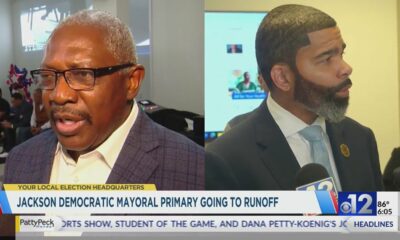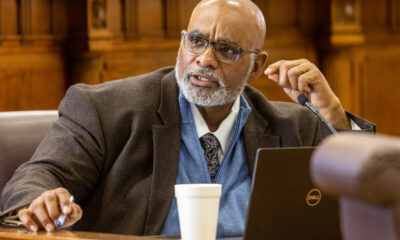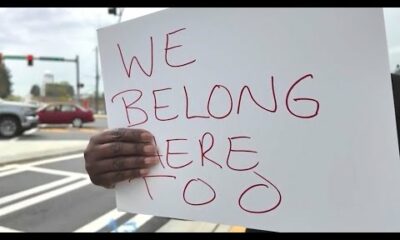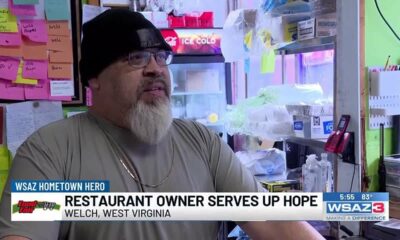Mississippi Today
Q&A: Feminist author Caroline Criado-Perez talks about the sometimes-deadly lack of data on the female body
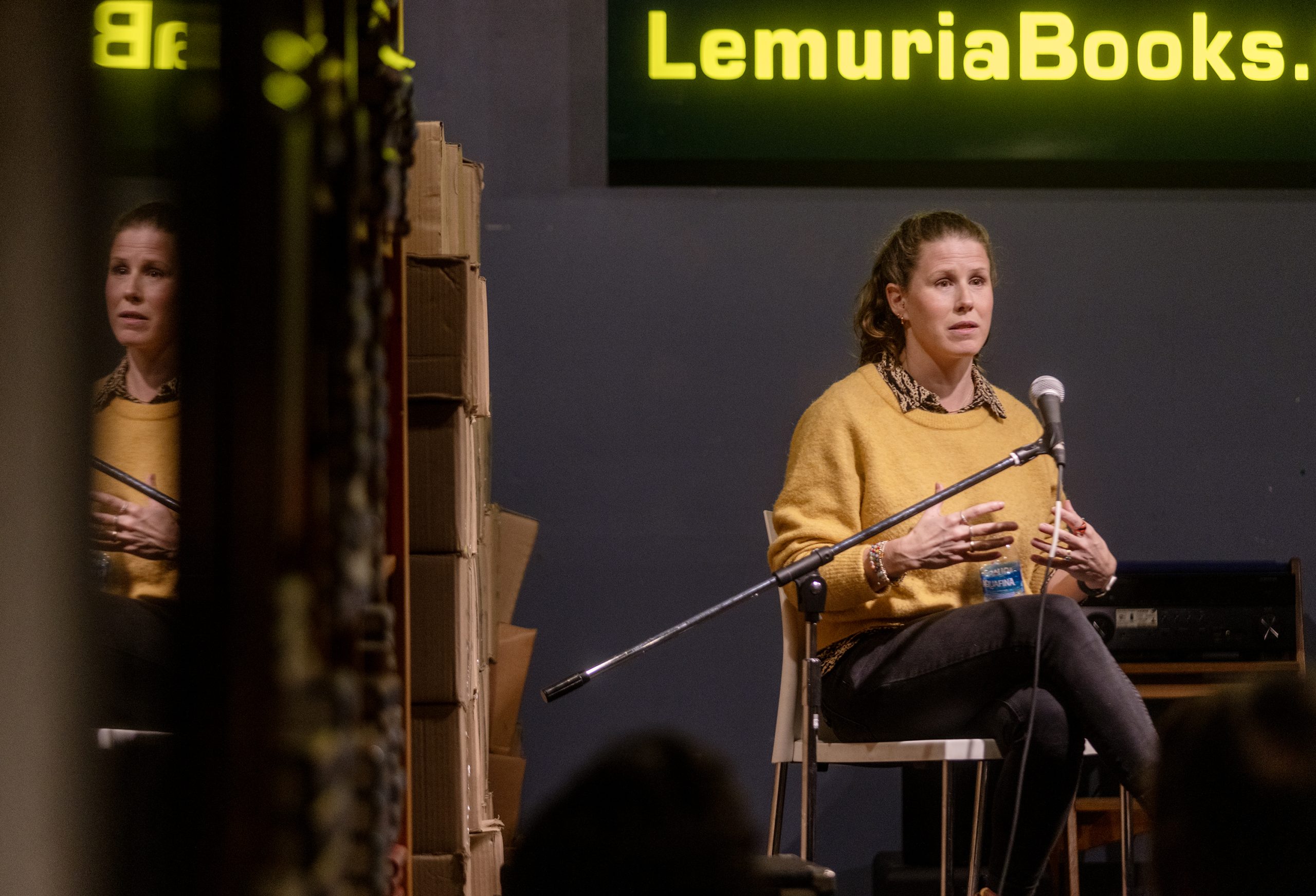
Note: This Q&A first published in Mississippi Today’s InformHer newsletter. Subscribe to our free women and girls newsletter to read stories like this monthly.
Caroline Criado-Perez, a feminist author and public speaker living in London, talked about her latest book, “Invisible Women,” last week at Lemuria Books in Jackson.
Her book, published in 2019, explores the gender data gap. From frustrating examples of a freezing office or a shelf out of reach, to deadly examples of an undiagnosed heart attack or crashing a car whose safety features don’t account for women’s measurements, Criado-Perez’s book is full of the real-world consequences of a world built without women in mind.
While the lack of research on the female body is an age-old problem, she argues, it becomes all the more pressing with the emergence of artificial intelligence and the increasing reliance on “Big Data.”
Criado-Perez is working on a new book about the reproductive journey of women, and how little science knows about it. She says she plans to use Mississippi as a case study. She sat down for an interview with Mississippi Today.
Editor’s note: This Q&A has been edited for length and clarity.
Mississippi Today: Tell us about the arc of your career and how you got to the point where you were writing your book “Invisible Women.”
Caroline Criado-Perez: Yeah so that’s a question with a very long answer. Really the story of me writing this book is the story of me becoming a feminist. I didn’t grow up as a feminist. I would say I was sort of anti-feminist – I was really quite misogynistic. And I think that was a very normal thing for young women in the ‘90s. I didn’t really identify with women and I just thought, you know, we’re all equal now and everyone should just stop complaining.
And it wasn’t until I went to university – I went as a mature student, I was 25 I think – and it was the first time I had to read any feminist analysis. And I had to read this book called Feminism and Linguistic Theory, which introduced me to the idea of the “generic masculine,” so, using “he” gender-neutrally or “man” gender-neutrally. The author of this book pointed to research that showed that when people hear these words or read these words, they think of men. And that completely blew my mind because it made me realize that I was picturing a man and I was incredibly shocked that I never noticed that, as a woman, that I’m just picturing men all the time.
That really kick-started the whole process for me because having had that realization, I started noticing it in other areas, where we act like we’re speaking gender-neutrally and we’re actually talking about men. So, after my first degree I went and studied feminist and behavioral economics and that is where I sort of discovered the whole economy is built around this mythical man – even though we speak about it being objective like a science. And there were various other bits and pieces I was doing that made me notice it in other areas and then finally I came across it in health, and that was when I was writing my first book. And that was when I started reading some research, the very early stages of my understanding of how much health and our knowledge of the human body is actually knowledge of the male body. That we’re not as good at diagnosing heart attacks in women as in men, and women are 50% more likely to be misdiagnosed if they have a heart attack. And more than anything I just couldn’t believe that this wasn’t on the front page of every newspaper, why did people not know this, why was everyone not talking about this – women are more likely to die if you have a heart attack: what?! And this is because we haven’t researched female bodies?
So that is how it ended up being a book. Essentially because I had all these things going around in my head and I felt like I was going crazy, that everyone was just blithely acting like we were speaking gender-neutrally when I knew we were talking about men. And just the fact that it was a huge, systematic issue, I knew that it wasn’t going to be an article – it had to be a book. Because it was just in everything.
MT: I’m interested in this term you use near the beginning of your book, “absent presence.” What is the experience of being defined by an absence, a negative space, a silence?
CP: I mean, I suppose for someone who recognizes the negative space, it’s intensely frustrating to know that there are all these gaps and all these silences that, as a society, we just skip over and we don’t notice that they’re there.
This is why I start the book with the Simone de Beauvoir quotation about representation being the work of men, and how they describe the world from their own point of view – which they confuse with the absolute truth. I f—–g love that quote so much. Because I feel like it sums up my book in a quotation because it’s not about these men having deliberately described the world and excluded women from it. They think that’s really what it is like. They think they’re really talking about the real world and they don’t see these absent presences, this silent figure of the woman.
But as a woman, you’re constantly knocking up against it, against the ways in which the world has not been designed for you. And having done the research I’ve done, I now experience the world in quite a different way than I did before, and it’s not a more comfortable way – it’s a much more uncomfortable way, because I’m constantly frustrated.
And of course, when it comes to health care it’s something that one thinks about a lot – you know, has this drug been tested in my body, is this the correct dosage for me, do they know how this drug interacts, and what if I’m on contraception, have they actually done any research? And nine times out of 10, no, they haven’t. Or they don’t know how the menstrual cycle might interact with it.
So it’s intensely frustrating and sometimes frightening, I think, to then just experience the world in which, for the most part, we are still speaking gender-neutrally when we’re talking about men.
MT: You talk about how this is an age-old problem – we live in a world made by men with men in mind. Can you tell us why, in a world that increasingly relies on “Big Data,” it matters so much more? How it becomes deadly, even?
CP: Yeah, so I mean, the gap in data for women is already deadly, if you’re thinking anywhere from car design to health care, but the real danger is becoming exponential, because of the introduction of AI into every single part of our world. And the problem with developing AI using bad data, biased data, is that machine learning is not like a human, in that it doesn’t simply reflect our biases back at us – it amplifies them.
I’ve read so many papers since “Invisible Women” came out where researchers will be like, “we’ve developed this AI and it performs better than a radiologist at detecting lung cancer” or “can predict heart attacks five years before they happen,” and then when you look at the paper, not only are the datasets incredibly male-biased, so you’ve got that bias already baked in, but also, they’re not even thinking about sex.
One paper I’m thinking about that came out shortly after “Invisible Women” was published was about predicting heart attacks. And there are sex-specific risk factors. So, if you’re going to be predicting heart attacks in men versus women, you don’t want to have, as this paper did, something like a 70% male dataset, but you even more don’t want to have that data all mixed up together. Because that’s not going to work for men or women. And yet, there was absolutely no mention of sex in the paper. So, that is frightening. Because the problem with that is it could make the situation worse.
When I find AI exciting is when researchers are using AI to address problems that we aren’t addressing otherwise. So, for example, one woman I spoke to was developing AI to detect victims of domestic violence via injury patterns, potentially years in advance of them ultimately having to be taken to a shelter or something. Because of course victims don’t necessarily report, and it’s not something that we’re investing a lot of money in in health care – because there’s not a lot of money in it and doctors don’t necessarily have the time to do the sort of questioning of a victim, et cetera. So there is exciting potential for AI. But if we’re just using it to do what we’re already doing but faster, that’s where the massive pitfalls are.
MT: As a health reporter, I’m interested in the subject of endocrine-disrupting chemicals you bring up in your book. We know that these chemicals are in everything, but they’re especially pervasive in feminine products, such as toiletries and makeup – and even menstrual products that women put inside their bodies. And as you know, not only are they more common in female products – they’re also worse for women, because of how they mimic and disrupt women’s hormones. How do we begin to address the issue? How can data help?
CP: The first thing that needs to change is obviously labeling – that’s a huge one, that people have the right to know what is actually in these products. That is one of the things that makes me most frustrated. I mean, as you can imagine, since writing the book I am scanning product ingredients all the time. If there’s anything that says “fragrance” I’m like “nope, that’s out, not using that.” And it’s amazing how many products just have these random ingredients in them and they don’t have to disclose what they are. Nobody knows. Nobody knows that “fragrance” means they could put anything in there. That’s deeply frustrating.
But my answer is always going to come back to: we have to collect data on this. And that is the thing that we’re not doing. And that is just incredible to me. The problem we have is not only are there endocrine-disrupting chemicals in these products, but also, how are these affecting not only the women who use them but also the women who work with them and the women who produce them.
And, as I say in my work, it’s not just that we haven’t tested them on women – for example, absorption into female skin, which can be different, or the way that it might accumulate in a female body, because of differences in fat in the body – but also the way in which women encounter them. Because it tends not to be in discrete “now I’m going to be exposed to this chemical, and tomorrow to that chemical.” We’re exposed to a cocktail of chemicals, and that’s not how they’re tested. So the way they’re tested is in itself biased against the way women are exposed to them, as well as the fact that we aren’t even testing them on women anyways.
And I feel that this really ties into this attitude that somehow the female workplace is this cozy, safe place, that women are never exposed to any form of danger. Because historically, the sort of headline-grabbing dangerous jobs have been done by men. By the way, because they were high-paying and women were barred from doing them, but let’s not let that get that in the way of the story that “women are lazy and they don’t want to do scary, difficult jobs.” But the female-dominated jobs that are low-paid, we simply have not been measuring how dangerous they are – from the perspective of exposure to chemicals.
MT: So, it seems like the call to action of this book is to begin filling in some of these gaps in data. But if we think of the modern world as being made up of data, then the idea of collecting all this new data can feel almost like building a new world – and that might be intimidating to some. What would you say to people who feel overwhelmed by this imperative?
CP: Well, there’s no getting around the fact that it is a huge job, and it is intimidating. And if you tried to do it all, you would be overwhelmed. But nobody could possibly fix this on their own. It’s like saying “you – go fix patriarchy.” It’s not how it works. Everybody has their own area that they can address. And so, people who work in research can collect sex disaggregated data. That’s a really great thing that people who work in research can do. People who work in HR, there’s a lot that they can do when it comes to looking at how their companies consider diversity, for example, in decision making.
People who have children, there’s so much that they can do to address how the future generation even notices that the “default male” operates. Like, if you look at kids’ TV, kids’ books, it’s “default male” all over the place – all the characters are male and if there’s a female character, her characteristic is that she’s female. I’m not saying that you’re going to be able to protect kids from that, but have a conversation with them. And I wish that had happened to me when I was little, that someone had taken the time to point out “isn’t it weird that in the real world, there’s all these women, and in your stories, it’s all boys?” I think that that’s a really powerful thing and I actually think that that’s something that everyone can do is have these conversations and notice when the “default male” is in operation – because I think that that really is half the battle.
If you think about the car crash stuff, that we have historically used an average male car crash test dummy, as if that’s representative of humans overall – when you say it like that, it obviously sounds ridiculous. But we’re so used to using the male body as the human body that people don’t even notice that it’s happening. As soon as you tell people “by the way, cars have not been tested to be safe for an average female body,” they understandably get really freaked out and start demanding change from car manufacturers – which is something very cool that’s happening in America at the moment. So, a really big part of it is just spreading the word and making the changes you can make.
MT: So, we’re talking about the gap in data around the female body and how that plays out in the health care system. One of the things I’ve noticed is that when people bring up this gap and try to address it – and particularly when talking about the menstrual cycle and how it interacts with medicine or what have you – that people tend to think of it as “woo-woo” or “mystical.” I think the fact that talking about something as fundamental as the menstrual cycle is met with such disbelief sheds light on just how uncommon it is to talk about the female body. Has that been your experience? Why is that?
CP: Right. That’s just sexism. It’s like, “oh, that has to do with ladies.” So, you’re reminding me of this report that came out, and again it was after “Invisible Women” was published, and it was about women and asthma. And there were all these testimonials from women who said “I went to the doctor and told them I feel like I get asthma flare-ups in relation to my menstrual cycle, I can tell where in my menstrual cycle I am, based on my flare-ups.” And the doctors were like “that’s just nonsense, you’re making it up” – because women can’t possibly know what’s going on with our bodies. Anyways, it transpires that actually, yes it is. It is hormonally-linked.
So that is something that, hashtag-not-all-doctors, but that they will say because there is this idea that lingers on somehow, in these people who are trained in science, that women are somehow just hysterical and should be less believed than men. But, I mean, that’s just misogyny.
MT: So you’re writing a new book. Tell us about how it relates to health care and how you’re using Mississippi as a case study.
CP: Yeah, so the book is about a woman’s reproductive journey from the beginning of whether or not she’s going to have children and going through things like pregnancy and how little we know about, firstly, how to treat a pregnant woman for anything, because we don’t do any research on women, let alone pregnant women. And then, how little we know about reproduction, so things like miscarriage and the disorders of pregnancy we know very little about, and of course that ties into abortion.
So that’s the area I’m wanting to focus on while I’m in Mississippi – for the obvious reason of Dobbs, and also my husband is from Mississippi, and also I had a miscarriage in January last year when we were last here, which was briefly scary, particularly as a British person, being here and thinking “if this goes wrong, am I going to be able to get the care I need?”
So I’m just really interested in understanding what it is actually like for a woman whose pregnancy goes wrong in Mississippi right now. Because I know there are these exceptions, but also, they’re never used. So, the focus for that chapter is I want to look at what happens to women who need an abortion and legally, supposedly, can get one, but actually, can’t get one. And then the rest of the book is looking at fertility and infertility through to the menopause.
This article first appeared on Mississippi Today and is republished here under a Creative Commons license.![]()
Mississippi Today
Early voting proposal killed on last day of Mississippi legislative session
Mississippi will remain one of only three states without no-excuse early voting or no-excuse absentee voting.
Senate leaders, on the last day of their regular 2025 session, decided not to send a bill to Gov. Tate Reeves that would have expanded pre-Election Day voting options. The governor has been vocally opposed to early voting in Mississippi, and would likely have vetoed the measure.
The House and Senate this week overwhelmingly voted for legislation that established a watered-down version of early voting. The proposal would have required voters to go to a circuit clerk’s office and verify their identity with a photo ID.
The proposal also listed broad excuses that would have allowed many voters an opportunity to cast early ballots.
The measure passed the House unanimously and the Senate approved it 42-7. However, Sen. Jeff Tate, a Republican from Meridian who strongly opposes early voting, held the bill on a procedural motion.
Senate Elections Chairman Jeremy England chose not to dispose of Tate’s motion on Thursday morning, the last day the Senate was in session. This killed the bill and prevented it from going to the governor.
England, a Republican from Vancleave, told reporters he decided to kill the legislation because he believed some of its language needed tweaking.
The other reality is that Republican Gov. Tate Reeves strongly opposes early voting proposals and even attacked England on social media for advancing the proposal out of the Senate chamber.
England said he received word “through some sources” that Reeves would veto the measure.
“I’m not done working on it, though,” England said.
Although Mississippi does not have no-excuse early voting or no-excuse absentee voting, it does have absentee voting.
To vote by absentee, a voter must meet one of around a dozen legal excuses, such as temporarily living outside of their county or being over 65. Mississippi law doesn’t allow people to vote by absentee purely out of convenience or choice.
Several conservative states, such as Texas, Louisiana, Arkansas and Florida, have an in-person early voting system. The Republican National Committee in 2023 urged Republican voters to cast an early ballot in states that have early voting procedures.
Yet some Republican leaders in Mississippi have ardently opposed early voting legislation over concerns that it undermines election security.
This article first appeared on Mississippi Today and is republished here under a Creative Commons license.
.
Mississippi Today
Mississippi Legislature approves DEI ban after heated debate
Mississippi lawmakers have reached an agreement to ban diversity, equity and inclusion programs and a list of “divisive concepts” from public schools across the state education system, following the lead of numerous other Republican-controlled states and President Donald Trump’s administration.
House and Senate lawmakers approved a compromise bill in votes on Tuesday and Wednesday. It will likely head to Republican Gov. Tate Reeves for his signature after it clears a procedural motion.
The agreement between the Republican-dominated chambers followed hours of heated debate in which Democrats, almost all of whom are Black, excoriated the legislation as a setback in the long struggle to make Mississippi a fairer place for minorities. They also said the bill could bog universities down with costly legal fights and erode academic freedom.
Democratic Rep. Bryant Clark, who seldom addresses the entire House chamber from the podium during debates, rose to speak out against the bill on Tuesday. He is the son of the late Robert Clark, the first Black Mississippian elected to the state Legislature since the 1800s and the first Black Mississippian to serve as speaker pro tempore and preside over the House chamber since Reconstruction.
“We are better than this, and all of you know that we don’t need this with Mississippi history,” Clark said. “We should be the ones that say, ‘listen, we may be from Mississippi, we may have a dark past, but you know what, we’re going to be the first to stand up this time and say there is nothing wrong with DEI.'”
Legislative Republicans argued that the measure — which will apply to all public schools from the K-12 level through universities — will elevate merit in education and remove a list of so-called “divisive concepts” from academic settings. More broadly, conservative critics of DEI say the programs divide people into categories of victims and oppressors and infuse left-wing ideology into campus life.
“We are a diverse state. Nowhere in here are we trying to wipe that out,” said Republican Sen. Tyler McCaughn, one of the bill’s authors. “We’re just trying to change the focus back to that of excellence.”
The House and Senate initially passed proposals that differed in who they would impact, what activities they would regulate and how they aim to reshape the inner workings of the state’s education system. Some House leaders wanted the bill to be “semi-vague” in its language and wanted to create a process for withholding state funds based on complaints that almost anyone could lodge. The Senate wanted to pair a DEI ban with a task force to study inefficiencies in the higher education system, a provision the upper chamber later agreed to scrap.
The concepts that will be rooted out from curricula include the idea that gender identity can be a “subjective sense of self, disconnected from biological reality.” The move reflects another effort to align with the Trump administration, which has declared via executive order that there are only two sexes.
The House and Senate disagreed on how to enforce the measure but ultimately settled on an agreement that would empower students, parents of minor students, faculty members and contractors to sue schools for violating the law.
People could only sue after they go through an internal campus review process and a 25-day period when schools could fix the alleged violation. Republican Rep. Joey Hood, one of the House negotiators, said that was a compromise between the chambers. The House wanted to make it possible for almost anyone to file lawsuits over the DEI ban, while Senate negotiators initially bristled at the idea of fast-tracking internal campus disputes to the legal system.
The House ultimately held firm in its position to create a private cause of action, or the right to sue, but it agreed to give schools the ability to conduct an investigative process and potentially resolve the alleged violation before letting people sue in chancery courts.
“You have to go through the administrative process,” said Republican Sen. Nicole Boyd, one of the bill’s lead authors. “Because the whole idea is that, if there is a violation, the school needs to cure the violation. That’s what the purpose is. It’s not to create litigation, it’s to cure violations.”
If people disagree with the findings from that process, they could also ask the attorney general’s office to sue on their behalf.
Under the new law, Mississippi could withhold state funds from schools that don’t comply. Schools would be required to compile reports on all complaints filed in response to the new law.
Trump promised in his 2024 campaign to eliminate DEI in the federal government. One of the first executive orders he signed did that. Some Mississippi lawmakers introduced bills in the 2024 session to restrict DEI, but the proposals never made it out of committee. With the national headwinds at their backs and several other laws in Republican-led states to use as models, Mississippi lawmakers made plans to introduce anti-DEI legislation.
The policy debate also unfolded amid the early stages of a potential Republican primary matchup in the 2027 governor’s race between State Auditor Shad White and Lt. Gov. Delbert Hosemann. White, who has been one of the state’s loudest advocates for banning DEI, had branded Hosemann in the months before the 2025 session “DEI Delbert,” claiming the Senate leader has stood in the way of DEI restrictions passing the Legislature.
During the first Senate floor debate over the chamber’s DEI legislation during this year’s legislative session, Hosemann seemed to be conscious of these political attacks. He walked over to staff members and asked how many people were watching the debate live on YouTube.
As the DEI debate cleared one of its final hurdles Wednesday afternoon, the House and Senate remained at loggerheads over the state budget amid Republican infighting. It appeared likely the Legislature would end its session Wednesday or Thursday without passing a $7 billion budget to fund state agencies, potentially threatening a government shutdown.
“It is my understanding that we don’t have a budget and will likely leave here without a budget. But this piece of legislation …which I don’t think remedies any of Mississippi’s issues, this has become one of the top priorities that we had to get done,” said Democratic Sen. Rod Hickman. “I just want to say, if we put that much work into everything else we did, Mississippi might be a much better place.”
This article first appeared on Mississippi Today and is republished here under a Creative Commons license.
Mississippi Today
House gives Senate 5 p.m. deadline to come to table, or legislative session ends with no state budget
The House on Wednesday attempted one final time to revive negotiations between it and the Senate over passing a state budget.
Otherwise, the two Republican-led chambers will likely end their session without funding government services for the next fiscal year and potentially jeopardize state agencies.
The House on Wednesday unanimously passed a measure to extend the legislative session and revive budget bills that had died on legislative deadlines last weekend.
House Speaker Jason White said he did not have any prior commitment that the Senate would agree to the proposal, but he wanted to extend one last offer to pass the budget. White, a Republican from West, said if he did not hear from the Senate by 5 p.m. on Wednesday, his chamber would end its regular session.
“The ball is in their court,” White said of the Senate. “Every indication has been that they would not agree to extend the deadlines for purposes of doing the budget. I don’t know why that is. We did it last year, and we’ve done it most years.”
But it did not appear likely Wednesday afternoon that the Senate would comply.
The Mississippi Legislature has not left Jackson without setting at least most of the state budget since 2009, when then Gov. Haley Barbour had to force them back to set one to avoid a government shutdown.
The House measure to extend the session is now before the Senate for consideration. To pass, it would require a two-thirds majority vote of senators. But that might prove impossible. Numerous senators on both sides of the aisle vowed to vote against extending the current session, and Lt. Gov. Delbert Hosemann who oversees the chamber said such an extension likely couldn’t pass.
Senate leadership seemed surprised at the news that the House passed the resolution to negotiate a budget, and several senators earlier on Wednesday made passing references to ending the session without passing a budget.
“We’ll look at it after it passes the full House,” Senate President Pro Tempore Dean Kirby said.
The House and Senate, each having a Republican supermajority, have fought over many issues since the legislative session began early January.
But the battle over a tax overhaul plan, including elimination of the state individual income tax, appeared to cause a major rift. Lawmakers did pass a tax overhaul, which the governor has signed into law, but Senate leaders cried foul over how it passed, with the House seizing on typos in the Senate’s proposal that accidentally resembled the House’s more aggressive elimination plan.
The Senate had urged caution in eliminating the income tax, and had economic growth triggers that would have likely phased in the elimination over many years. But the typos essentially negated the triggers, and the House and governor ran with it.
The two chambers have also recently fought over the budget. White said he communicated directly with Senate leaders that the House would stand firm on not passing a budget late in the session.
But Senate leaders said they had trouble getting the House to meet with them to haggle out the final budget.
On the normally scheduled “conference weekend” with a deadline to agree to a budget last Saturday, the House did not show, taking the weekend off. This angered Hosemann and the Senate. All the budget bills died, requiring a vote to extend the session, or the governor forcing them into a special session.
If the Legislature ends its regular session without adopting a budget, the only option to fund state agencies before their budgets expire on June 30 is for Gov. Tate Reeves to call lawmakers back into a special session later.
“There really isn’t any other option (than the governor calling a special session),” Lt. Gov. Delbert Hosemann previously said.
If Reeves calls a special session, he gets to set the Legislature’s agenda. A special session call gives an otherwise constitutionally weak Mississippi governor more power over the Legislature.
This article first appeared on Mississippi Today and is republished here under a Creative Commons license.
-

 Mississippi Today2 days ago
Mississippi Today2 days agoPharmacy benefit manager reform likely dead
-

 News from the South - Alabama News Feed7 days ago
News from the South - Alabama News Feed7 days agoSevere storms will impact Alabama this weekend. Damaging winds, hail, and a tornado threat are al…
-

 News from the South - Alabama News Feed6 days ago
News from the South - Alabama News Feed6 days agoUniversity of Alabama student detained by ICE moved to Louisiana
-

 News from the South - Oklahoma News Feed5 days ago
News from the South - Oklahoma News Feed5 days agoTornado watch, severe thunderstorm warnings issued for Oklahoma
-

 News from the South - Virginia News Feed6 days ago
News from the South - Virginia News Feed6 days agoYoungkin removes Ellis, appoints Cuccinelli to UVa board | Virginia
-

 News from the South - Kentucky News Feed7 days ago
News from the South - Kentucky News Feed7 days agoA little early morning putting at the PGA Tour Superstore
-

 News from the South - Georgia News Feed5 days ago
News from the South - Georgia News Feed5 days agoGeorgia road project forcing homeowners out | FOX 5 News
-

 News from the South - West Virginia News Feed6 days ago
News from the South - West Virginia News Feed6 days agoHometown Hero | Restaurant owner serves up hope








